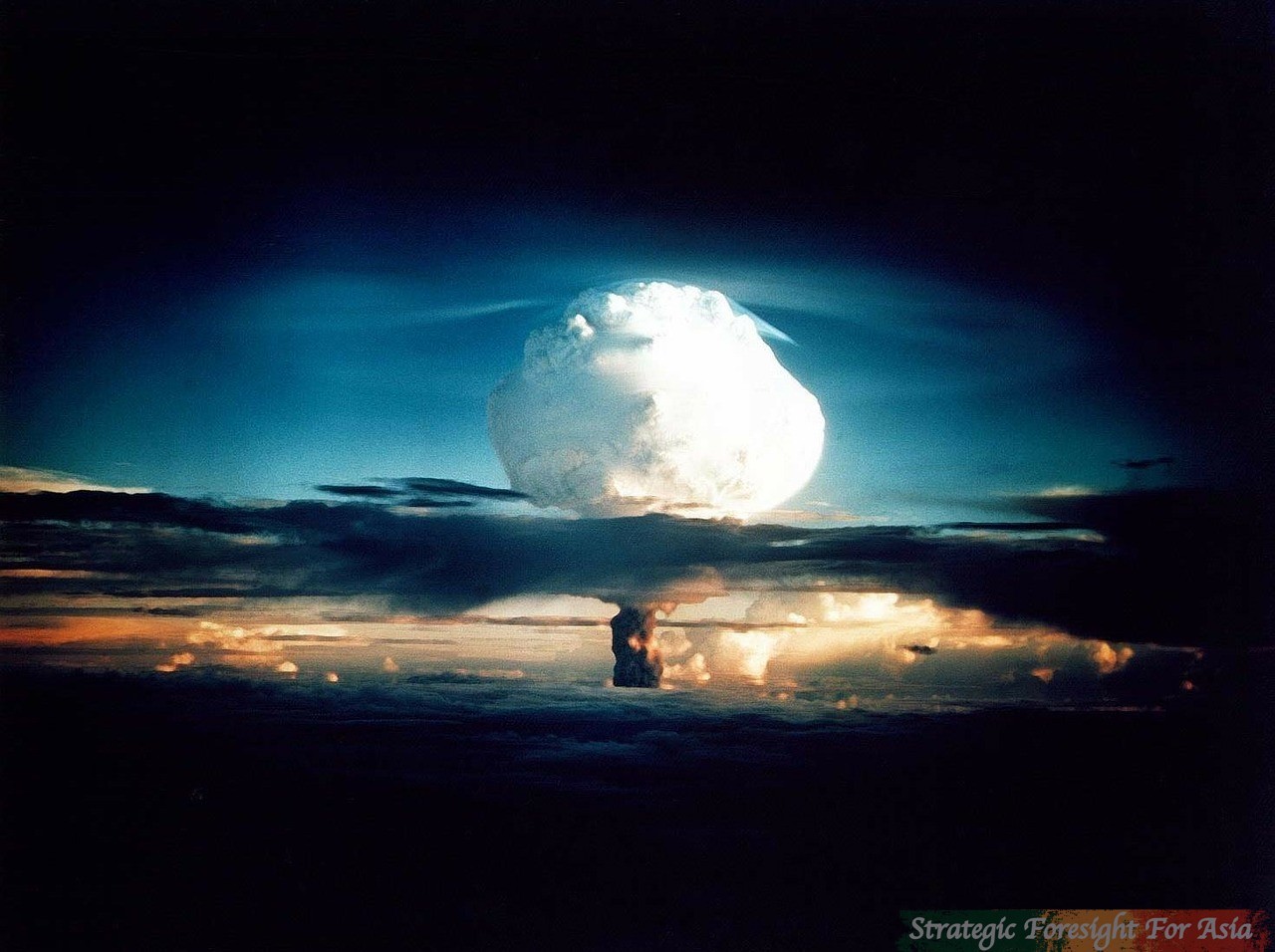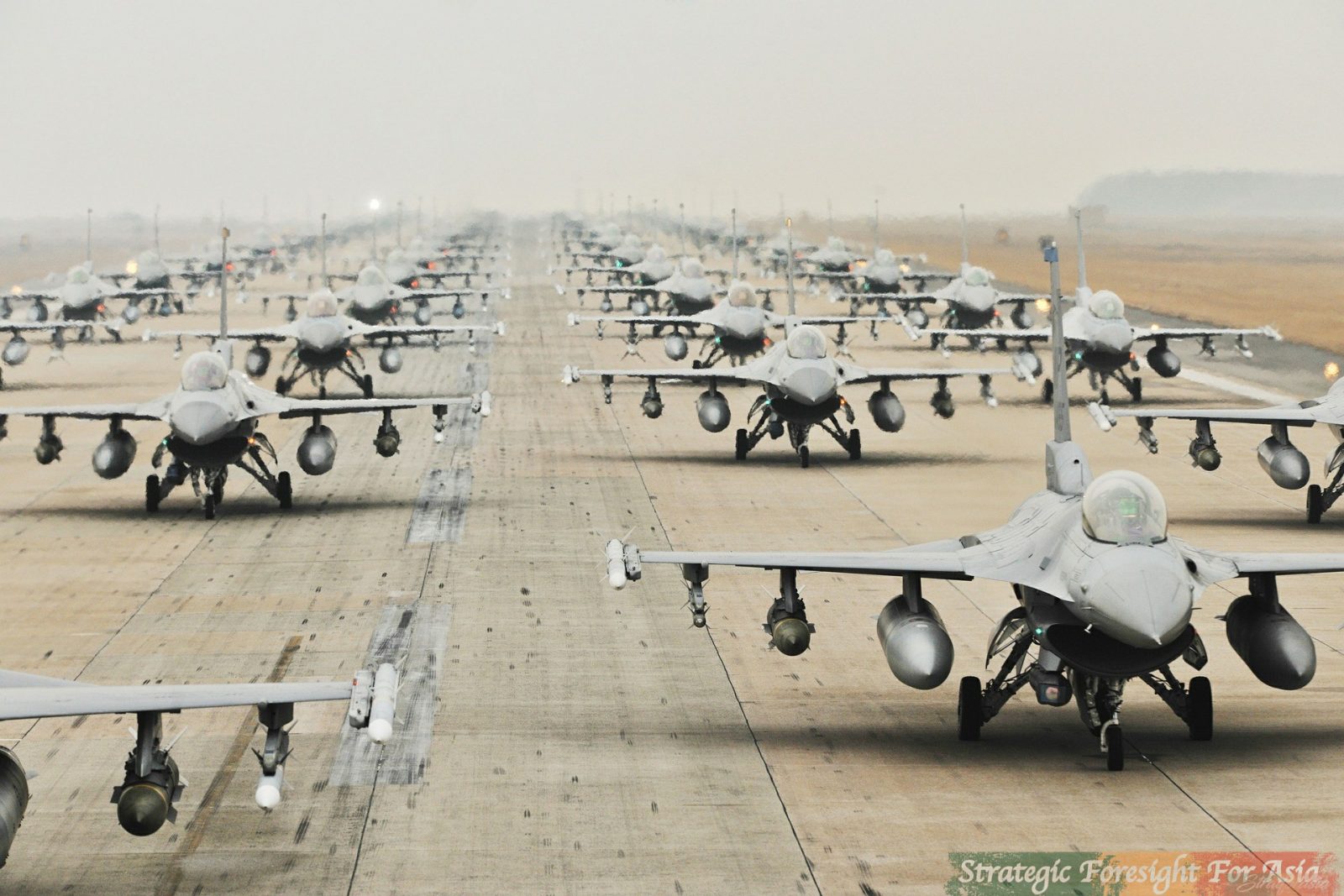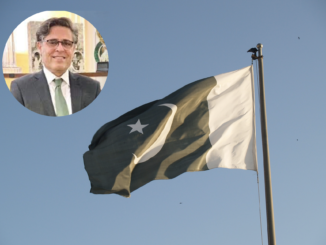
Pakistan’s geographical location at the crossroads of West, Central and Southeast Asia has brought along unique challenges and played an important role in shaping its policy outlook since its creation. Pakistan’s post-independence security environment was marred with the ongoing conflict with India over Kashmir, and it was further exacerbated due to the weak economy and almost nonexistent defence/military infrastructure. India’s massive conventional military buildup exposed Pakistan’s conventional asymmetry and posed an existential threat to the very survival of the state and got multiplied due to India’s early nuclear adventures. Initially, it sought West’s security assurances, but that aspiration dashed to the ground repeatedly. Thus Pakistan opted the nuclear route as a reaction to India’s military ambitions.
Pakistan’s move in nuclear trajectory trails behind a number of controversies mostly based on conjectures due to the opacity overlapping its nuclear policy. This deliberate opacity has also given birth to numerous speculations, hence making it difficult to separate myth from reality. It initially targeted Pakistan’s capability to develop nuclear weapons and later, its credibility to securely maintain a nuclear arsenal.
This article traces the origin of Pakistan’s nuclear thinking and tries to identify the rationale that underscores its nuclear development. The narrative covers the early and recent history of nuclear development to give a detailed overview. While keeping the main emphasis on various phases of nuclear development to highlight the underlying motives, it also delves into the realm of the contemporary debate on Pakistan’s nuclear outlook and addresses the prevailing controversies.
Tracing the origin of nuclear knowledge
Pakistan’s pursuit of nuclear energy can be traced back to 1950 unlike neighbouring India, whose association with nuclear knowledge predates 1947. Pakistan, being one of the beneficiaries of “Atom for Peace” programme, got acquainted with it only in the mid-1950s when an “Atom for Peace” exhibition toured Pakistan.
Creation of a national atomic research unit was announced in October 1954. However formal work began with the establishment of Atomic Energy Research Council in 1956 (later became Pakistan Atomic Energy Commission) at Karachi under the chairmanship of Dr Nazir Ahmad. It started its modest programme of primary research with a group of about ten people.
In the early years, nuclear research faced numerous obstructions and other bureaucratic hurdles due to lack of interest and enthusiasm at the governmental level. Later, when Dr I.H. Usmani took the lead of PAEC, Pakistan’s peaceful nuclear programme got stimulated. Dr Abdul Salam, the then chief scientific advisor to the President and the only Pakistani Nobel Laureate of the future also shared his enthusiasm. Significant support came from Zulfiqar Ali Bhutto the then Minister of Fuel, Power and Natural Resources. This trio worked for a robust system and managed to get necessary financial resources to support their ambitions. At that time, however, there was no vision of getting into the weapons programme. Dr Usmani, although a nuclear energy enthusiast, was particularly known for his aversion to the nuclear weapon programme.
The first major development in Pakistan’s nuclear programme was the establishment of the first pool-type research reactor at the Pakistan Institute of Nuclear Science and Technology (PINSTECH) in 1963. It was supplied by the U.S. under IAEA safeguards. In 1965, Pakistan entered into an agreement of cooperation with Canada, to set up Karachi Nuclear Power Plant (KANUPP) that was formally inaugurated in 1972. Meanwhile, PAEC also proposed to set up two research centres for the use of radioisotopes in agriculture and food preservation and also to establish eight medical centres for the treatment of cancer thereby indicating their sole interest in peaceful nuclear applications. Another important step taken at that time was capacity building. A large number of young scientists and engineers were sent abroad for higher education in the field of nuclear technology. Some of them would, later on, contribute to Pakistan’s weapon programme.
Strategic thinking going nuclear
Regional dynamics played a pivotal role in igniting the idea of military use of nuclear technology and kindled nuclear weapons ambitions in Pakistan’s scientific and political leaders alike. India continued to pose an existential threat to Pakistan since independence, and 1965 war was an eye-opener for the strategic community in Pakistan where the expected security umbrella from the U.S. under SEATO and CENTO did not materialize. In addition, India’s known endeavours in the nuclear field further aggravated the security concerns. After 1965 Indo-Pak war, Foreign Minister Zulfiqar Ali Bhutto while visiting IAEA in October 1965 met with Munir Ahmed Khan, a Pakistani nuclear engineer, who at that time was IAEA’s Director of Nuclear Power and Reactor Division. Munir Ahmed Khan informed Bhutto of the status of Indian nuclear weapon programme. Bhutto, who was already thinking on these lines, arranged a meeting of Munir Ahmed with President Ayub Khan in December 1965 where he briefed the President about the Indian intentions and suggested to work on the same lines. President Ayub, however, dismissed the idea for its economic impact and stated, “…if we ever need the bomb, we will acquire it off the shelf.” This event is perhaps the first instance of a discussion on acquiring nuclear weapon capability but did not receive official patronage. Therefore, it put the nuclear weapon ambitions in the back burner for the next several years. However, Pakistan continued to view India’s dubious moves cautiously, and it was that sense of insecurity based on which Pakistan refused to be part of “grand bargain” that NPT offered despite its positive role in NPT negotiations and linked its signing of the treaty with India’s action in this regard.
Multan rendezvous and quest for the bomb
The war with India in 1971 and subsequent dismemberment of Pakistan proved to be a turning point in the decision to develop nuclear weapons. As a reminiscent of 1965, it exposed Pakistan’s conventional inferiority vis-a-vis India and fallacy of Western claims of helping Pakistan at the time of crisis. Soon after ZA Bhutto assumed power and got the chance to realize his long-held nuclear dream. He called the famous Multan Meeting of nuclear scientists on January 20, 1972, where he formally unfolded his nuclear ambitions. This time his rhetoric turned into substantive resolve, and first important step in this direction was appointing Munir Ahmed Khan as Chairman of PAEC, who shared Bhutto’s nuclear weapon enthusiasm. Bhutto made another logical move of bringing PAEC directly under his control, thereby removing all bureaucratic hurdles in the way of initiating research in weapon field.
Indian PNE and Pakistan’s nuclear weapon development
Driven by its security concerns, Pakistan kept a close watch on Indian intentions and moves in nuclear weapon development. Following China’s nuclear tests in 1964, there was a recurrent debate in India to follow the same path. India’s premier Nuclear Scientist Homi Bhaba’s assertion that India could detonate a nuclear device in 18 months was cautiously viewed in Pakistan. In addition, India’s procurement of plutonium reprocessing plant in 1965 and Pakistan’s numerous failed attempts to convince U.S. and Canada that India is moving on the road to go nuclear further accentuated Pakistan’s anxiety.
Pakistan’s worst nightmare was confirmed when India conducted its first nuclear test in the Pokhran desert by diverting the material of CIRUS facility provided by Canada. India ironically named it “Smiling Buddha” and her subsequent reassurances by labelling it a “Peaceful Nuclear Explosion” (PNE) however, could not ally Pakistan’s concerns. There were serious apprehensions, and it was viewed as another move to intimidate Pakistan. As a reaction, pressure on Pakistan increased and Canada stopped the fuel supply to KANUPP; however, it could not circumvent Pakistan’s intention to reciprocate. It became a defining moment for the future course of action and road to Chaghi began to be built. The period following 1974 can be divided into the following two phases.
Development phase (1974-1998)
During this phase, PAEC began to work on the nuclear fuel cycle and indigenously started various phases of developing the necessary infrastructure to this end. This included plants for exploration of uranium, mining, enrichment, conversion, enrichment, fuel fabrication and reprocessing and the facilities for designing, manufacturing and testing for a nuclear device. Foreseeing the future impediments, Pakistan could face on its nuclear journey, ZA Bhutto, had instructed the scientists at the Multan meeting in 1972 to initiate thorough research in both routes to a nuclear device, i.e. Uranium enrichment and Plutonium reprocessing. Therefore Pakistan entered into negotiations with French Firm Saint-Gobian Techniques Nouvelles (SGN) to acquire Chashma reprocessing Plant. Pakistan tried to justify the acquisition of the reprocessing plant on the grounds of its ambitious civil nuclear programme. However, it could not substantiate its claims that added to the suspicions. Despite the provision of adequate IAEA safeguards, France succumbed to the U.S. pressure and abrogated the deal in 1978.
Pakistan had begun to work on Uranium exploration at an early stage when it started its peaceful nuclear programme. In 1961, PAEC had set up two Mineral Centers one at Lahore and the other at Dhaka tasked to explore uranium in the country. The Lahore Center would, later on, provide some indispensable individuals for Pakistan’s nuclear programme.
Uranium deposits were discovered in Dera Ghazi Khan in 1963 and mining was started in the same year. PAEC set up a uranium refining in the 1970s at Baghalchur, Dera Ghazi Khan and the Chemical Production /Plant Complex (CPC) for the refinement of yellow cake and processing into oxide metal and gas. Initially, it only supplied uranium dioxide to make fuel for Karachi power plant. (The same facility later would be used to provide Uranium Hexafluoride (HF6) for the enrichment plant at Kahuta Research Laboratories (KRL).
Another important pre-requisite was essential procurements for infrastructural development. Pakistan greatly benefitted from the non-existence of ban on import of dual-use items in the early phase of nuclear weapon development. Realizing that the situation would change any time soon, Munir Ahmad Khan made a detailed analysis of available indigenous resources and identified the necessary items to be procured from abroad. All these procurement were made easily due to western firms’ willingness to sell technology. The process continued undetected despite growing international concerns. The first IAEA guidelines were published in 1974 and later in 1978; the first NSG guidelines were published that covered mostly plutonium technology as they came in reaction to India’s explosion. However, it became challenging to acquire dual-use items directly, and Pakistan began to purchase individual components to assemble them indigenously.
En route to uranium enrichment, PAEC launched its “Project 706” in 1974 at Chaklala that was later on handed over to Dr Abdul Qadeer Khan – a metallurgist who at that time was working at Urenco uranium enrichment consortium in the Netherlands. Dr Khan was privy to a few classified documents where he got hold of the blueprint of Urenco’s centrifuge design. He wrote a letter to Mr Bhutto and later, on his return to Pakistan in early 1976, joined the centrifuge programme at PAEC. At that time, PAEC had already begun preliminary work on centrifuge technology, but A.Q. Khan’s arrival gave this project a new impetus. Soon after his joining the organization, Dr Khan demanded a complete administrative and financial autonomy, which was granted to him. No individual other than Dr Khan enjoyed such independence as PAEC had maintained strict oversight and a robust internal auditing system.
Another crucial parallel step was the selection and preparation of the site for the tests. Site exploration mission started in 1976 in the barren and least populated province Baluchistan by a PAEC team and search ended at Ras Koh Hills and the Kharan desert. Site preparation and digging of tunnels was an uphill task that involved a number of complexities and was completed in 1980, without giving much hint to the potential eavesdroppers. Despite discernible concerns regarding Pakistan’s nuclear programme, the 1980s saw massive development in nuclear technology and weapon designs mainly due to U.S.’ deliberate complacency towards Pakistan for its indispensable role in securing American interests in Afghanistan. Despite observing an upswing in Pakistan’s nuclear activities, the U.S. did not invoke the Solarz Amendment and Pressler Amendment enacted by Congress in 1985 and continued providing annual certification.
By the early 1980s, PAEC completed several other plants in the nuclear fuel cycle. The country reached a historic milestone when on March 11, 1983, PAEC carried out the first cold test of a working nuclear device. This was followed by a number of more cold tests, while KRL had produced enough enriched uranium for one device by the mid-1980s. In 1986, PAEC also began work on the 50 M.W. indigenous heavy water reactor for plutonium production at Khushab along with a heavy water plant. At the same time, there were a plethora of news reports moving back and forth claiming China had transferred nuclear weapon design information to Pakistan ignoring the fact that Chinese plants were based on gaseous diffusion technology and had no experience in gas centrifuge technology that Pakistan had replicated based on European designs.
International pressure on Pakistan due to its ongoing nuclear activities coincided with a growing sense of insecurity vis-a-vis India. Therefore Pakistan continued its policy of deliberate nuclear ambiguity throughout the development phase. To offset some of these pressures, Pakistan proposed certain arms control and disarmament measures at different intervals aimed at neutralizing Indian threat and highlighting its genuine sense of insecurity. Soon after Indian PNE in 1974, Pakistan proposed a “South Asian Nuclear Weapon Free Zone” in U.N. General Assembly. Later starting from a formal proposal by Pakistan in 1981 to initiate bilateral talks to conclude an agreement on a mutually acceptable ratio of conventional armed forces, a series of proposals were given by Pakistan over the next few years, duly termed as “peace offensive” by the then foreign minister Agha Shahi. That included renunciation on acquisition of nuclear weapons by both India and Pakistan (1978), comprehensive mutual inspection of each other’s nuclear facilities (1979), simultaneous mutual acceptance of IAEA “Full Scope Safeguards” (1979), simultaneous accession to the NPT (1979), a bilateral South Asian Comprehensive Test Ban Treaty (1987), and a mutual conference under the U.N. auspices on Nuclear Non Proliferation in South Asia (1987). All these measures fell victim to Indian rigidness on this matter. In addition, non-cooperation of the international community on relieving Pakistan’s sense of insecurity gave impetus to her efforts to create an independent nuclear deterrent.
U.S. attitude towards Pakistan dramatically changed at the end of the Cold War, when Pakistan lost its geopolitical importance after Soviet withdrawal from Afghanistan. The first shot came in the form of President Bush’s refusal to certify to U.S. Congress that Pakistan is not developing a nuclear arsenal invoking the Pressler amendment that cut off economic aid to Pakistan. It was followed by a series of attempts to force Pakistan to roll back its nuclear programme through a carrot and stick policy.
Overt Nuclearization: Ticking towards “Pakistan’s Finest Hour”
1998 general elections in India brought the National Democratic Alliance led by Bhartiya Janta Party to power. Nuclear development was the top agenda on their party manifesto. Moving in that direction, India conducted five nuclear tests on 11 and 13 May 1998 and this time did not hedge them behind a PNE label. Before the dust could settle in Pokhran desert, Indian media and leadership unleashed frenzy propaganda calling for a ‘hot pursuit’ into Pakistan’s territory, that created a great sense of insecurity. Milder international response to Indian tests further aggravated Pakistan’s concerns.
The seventeen days interval between Indian and Pakistani tests was filled with tension and great anxiety. To weigh the options a meeting of Defence Committee of the Cabinet (DCC) was convened at the Prime Minister’s Secretariat on May 15. There were two points on the DCC’s agenda, first, should Pakistan carry out tests and secondly if Pakistan does go ahead with the tests then which of the two organizations, PAEC or KRL, should be given the task? Both agenda items remained inconclusive. Later on 16 or 17 May another meeting of DCC was held in which decision was made to carry out the tests, and PAEC was given the prime responsibility.
The U.S. exerted immense pressure on Pakistan to dissuade the leadership from undertaking the tests. There was a serious threat of a pre-emptive strike through a joint operation of Indian and Israeli air force. Amidst all the pressures Pakistan conducted five successful tests on May 28, 1998, and another on May 30. Pakistan termed it “the finest hour” and an inevitable step for national defence. It gained popular support at the national level and was unanimously hailed by all major political parties however widely condemned at international level and invited immediate imposition of sanctions.
The advent of nuclear weapons in South Asia has changed the strategic dynamics to a greater extent. Recent developments, however, paint a bleak picture where strategic stability has become even more fragile. It has the potential to bring the region on the periphery of a nuclear holocaust hence demands close scrutiny of all associated factors.
It brings into focus the fundamental question of a state’s decision to go nuclear. Scott Sagan argued that “States that face nuclear adversaries will eventually develop their own arsenals unless credible alliance guarantee with a nuclear power exists”. The historical account of Pakistan’s nuclear development illustrates that Pakistan opted this route only after having failed to secure its interests through outside support and viewed nuclear weapons as an ultimate source of deterrence. The analysis of Pakistan’s nuclear development supports the argument that Pakistan’s primary motive was to seek refuge in nuclear development against India’s growing conventional superiority.
In Indo –Pak strategic calculus, nuclear optimism finds some place and many scholars are of the view that nuclear deterrence has been functioning in South Asia since the overt nuclearization of both the states. However, it remains the fact that it has now engulfed the region in a nuclear arms race mainly due to the preferential treatment of one state against the other. India’s unhindered nuclear pursuits are pushing Pakistan to consider response options that might lead to the unwanted escalation that according to Robert Jervis can be a rational choice in some instances motivated by “national honour, the desire to harm and weaken those who represent abhorred values and the belief that the other will retreat rather than pay the price which can be expected for victory”. Such practice would increase the risk of nuclear war, and if continued unchecked, it would render deterrence only an ephemeral phenomenon.
At the global level, calls for nuclear disarmament are reverberating; these measures are trying to tone down the image of nuclear weapons as an element of prestige, but it is not addressing the concerns of the states who developed these weapons purely for security purposes. Such attempts prove futile since they are dealing with the symptoms without analyzing the root causes. In South Asian case, it is, therefore, necessary to take into consideration the underlying problems that are providing impetus to the nuclear development and attempt should be made to resolve the issues that have actually generated the hostility. In this regard idea of a “Strategic Restraint Regime” should be revisited that provides a broader framework and calls for the prevention of nuclear weapons and ballistic missile race, the establishment of risk reduction mechanisms to avoid a nuclear conflict and resolution of all outstanding issues for lasting peace in the region.
Sitara Noor is a director at a Lahore-based policy consultancy. Previously Sitara was a Research Fellow at the Vienna Center for Disarmament and Non-Proliferation (VCDNP) in Vienna, Austria. Before joining the VCDNP, she worked at the Pakistan Nuclear Regulatory Authority under the Directorate of Nuclear Security and Physical Protection as an International Relations Analyst.
This article was first published in an Italian Journal Limesonline
![]()





Be the first to comment